RDP 2024-06: Examining the Macroeconomic Costs of Occupational Entry Regulations 4 Documenting the stringency of OER across jurisdictions
September 2024
- Download the Paper 1.59MB
This section examines patterns in OER across occupations and jurisdictions to better understand the nature of OER in Australia, and in New South Wales in particular. Reform opportunities can be identified by examining whether quality/standards have been comparable in other jurisdictions that have less stringent OER. These reform opportunities require further analysis that assesses the benefits of various OER, which is beyond the scope of this paper.
4.1 Australia's OER are more stringent for select occupations than other OECD countries
OER in Australia's largest states are more restrictive compared to the least stringent OECD countries, such as Sweden and Switzerland (Figure 2).[3] This suggests that there may be scope to reduce the stringency of OER in Australia if other jurisdictions have been able to achieve comparable or even better quality/safety outcomes.
Relative to the OECD average level, OER in Australia's three largest states tend to be more stringent in personal services – those provided directly to individuals, such as a baker or electrician – and less stringent for professional services occupations – specialised services provided by professionals with specific expertise to clients or businesses, such as a lawyer or accountant.
There are also differences across states, with OER tending to be more stringent in New South Wales, compared to Queensland and Victoria.
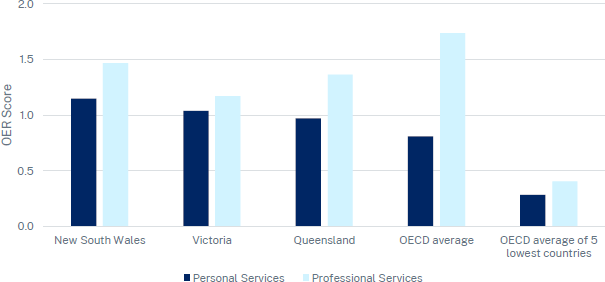
Note: Scores reflect the average aggregate scores for the ten personal service and five professional service occupations listed in Table 3.
Source: NSW Treasury and the Reserve Bank of Australia, von Rueden and Bambalaite (2020).
Focusing on occupations in New South Wales, OER are more stringent for hairdressers, electricians, driving instructors, architects, and real estate agents compared to other jurisdictions (Figure 3). This reflects more stringent qualification requirements and more onerous mobility restrictions across states and countries (Figure 4).
Ongoing efforts are underway to reduce mobility restrictions across states in Australia through the automatic mutual recognition (AMR) of licences. This means if someone is licensed to perform an activity in one state or territory, they can perform the same activity in other participating states where those activities are recognised and licensed. However, the potential benefits of AMR have not been realised as many occupations in New South Wales have been exempt from the scheme, which commenced in 2021. Exemptions have been granted due to the perceived risk to the health and safety of workers or the public.
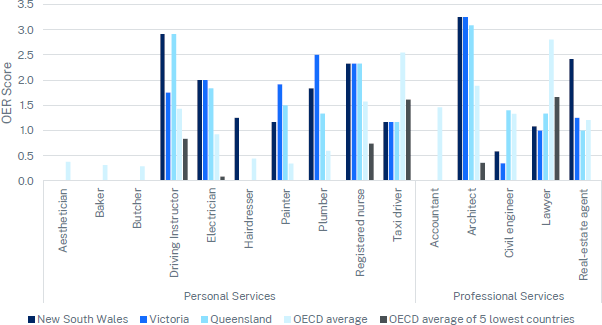
Note: The OECD average of 5 lowest countries refers to those countries that score the lowest within each respective occupation.
Source: NSW Treasury and the Reserve Bank of Australia, data: von Rueden and Bambalaite (2020).
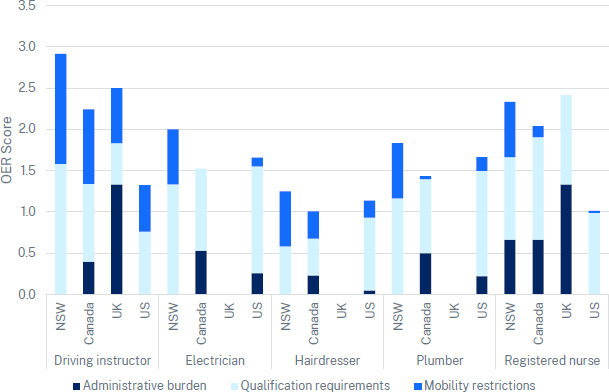
Source: NSW Treasury and the Reserve Bank of Australia, data: von Rueden and Bambalaite (2020).
4.2 New South Wales imposes stricter OER for several construction-related occupations compared to Queensland and Victoria
The building and construction industry is highly regulated and employs a significant number of workers in New South Wales and Australia. In recent years, licensing arrangements in the building and construction sector have become more stringent across most Australian states, typically driven by higher entry requirements (Commonwealth Productivity Commission 2023). The industry is also facing significant shortages of skilled workers that is impacting the delivery of infrastructure and housing projects. The National Skills Commission found that all construction trades occupations are in shortage across Australia (National Skills Commission 2021). While occupational regulation may aim to minimise the risks of consumer detriment, particularly building defects, it may also restrict the adaptability of the workforce.
We measure the stringency of OER across 14 select occupations in the building and construction sector in New South Wales, Queensland, and Victoria ( Figure 5). OER are notably more stringent in New South Wales compared to other states for air conditioning and refrigeration (AC&R) mechanics. Likewise, New South Wales is considerably more stringent for project builders compared to Queensland.
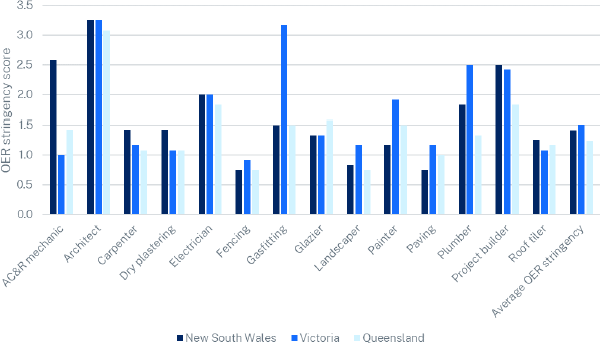
Sources: NSW Treasury and the Reserve Bank of Australia.
4.3 OER are prevalent across the most common occupations in New South Wales
OER are commonplace across the NSW economy. Of the 100 most common occupations in New South Wales, 43 of them had some form of OER, with formal licences or mandatory education requirements being the most common form (Figure 6).[4] OER tended to be higher in the health sector, and the building and construction sector. Both are somewhat unsurprising, given the potential for consumer harm stemming from poor provision.
Qualification requirements were the greatest contributor to the stringency of OER for most of the top 100 occupations subject to occupational regulation. Further work could investigate whether the qualification requirements for occupations is effective and proportional in improving the quality of services provided. For example, the NSW Productivity Commission (2023) found that increasing the qualification requirements for aspiring teachings from a one-year Graduate Diploma of Education to a two-year Master of Teaching degree was not effective. The change had a negligible impact on student achievement but imposed considerable costs on aspiring teachers.
Mobility restrictions are also consistently an important contributor, adding to the OER indicator for four out of five regulated occupations. Of these 34 occupations, half of them had limited ability to recognise skills gained abroad, and more than half required local exams to be taken for qualifications gained outside of New South Wales. This highlights the large number of potential occupations that could benefit from the automatic mutual recognition of licences.
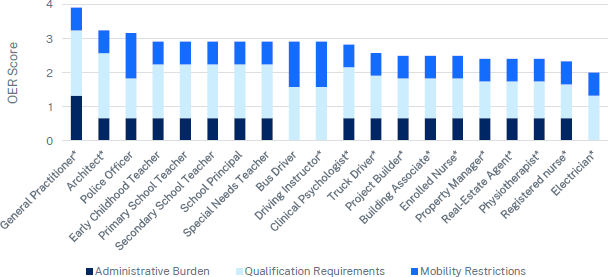
Note:
Scores for bus drivers and driving instructors appear unusually high due to requirements for drivers to obtain a local driving licence, in addition to further qualification and registration requirements. Scores would appear lower if it was assumed that an aspiring individual already holds a local driving licence.
*Indicates occupation is regulated by a licensing scheme.
Source: NSW Treasury and the Reserve Bank of Australia.
Footnotes
These tend to include countries such as Sweden, Finland, Switzerland, and in some cases Great Britain, the United States, and Spain. [3]
The list of occupations was based on the 2021 Census and excludes executive and managerial positions (see appendix A). Note the executive and managerial positions were excluded where their roles were too vague to identify specific occupational regulations, for example, Chief Executive Officer. [4]